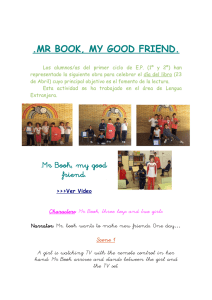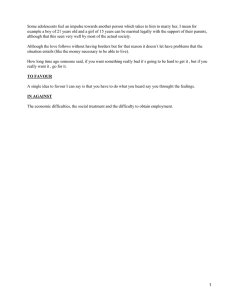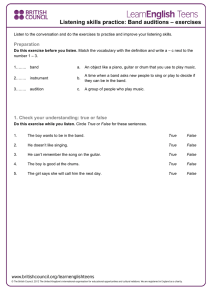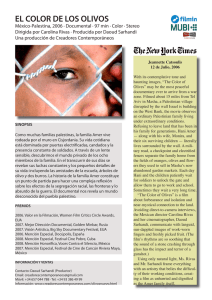Falling in Love with the Wind
Anuncio
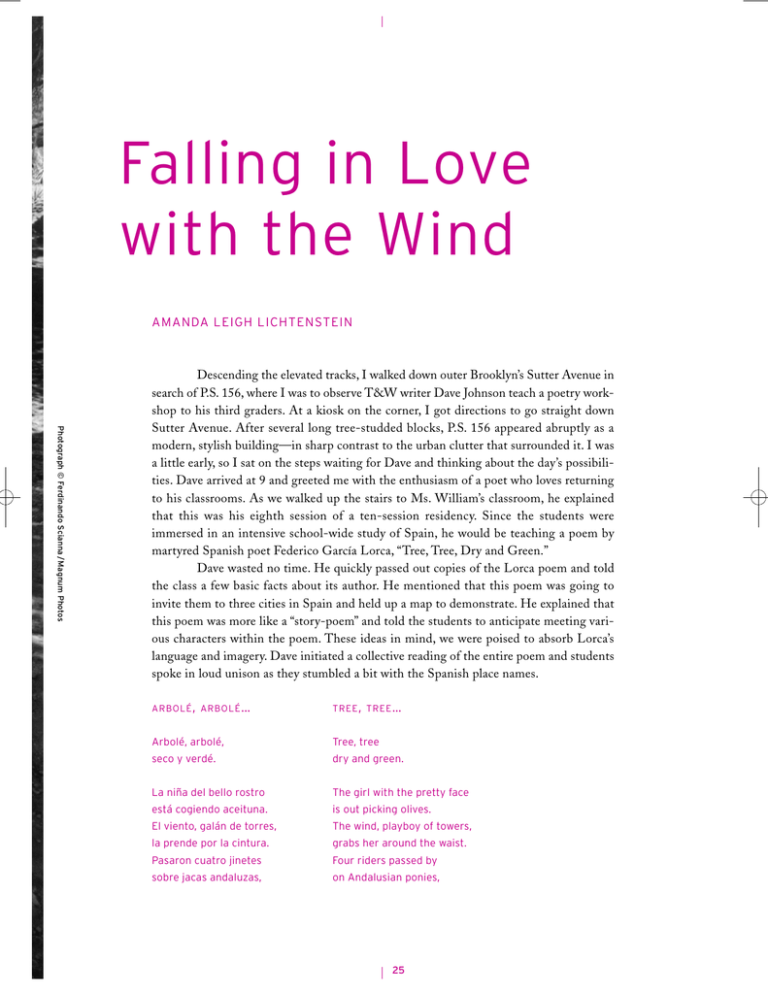
Falling in Love with the Wind AMANDA LEIGH LICHTENSTEIN Photograph © Ferdinando Scianna / Magnum Photos Descending the elevated tracks, I walked down outer Brooklyn’s Sutter Avenue in search of P.S. 156, where I was to observe T&W writer Dave Johnson teach a poetry workshop to his third graders. At a kiosk on the corner, I got directions to go straight down Sutter Avenue. After several long tree-studded blocks, P.S. 156 appeared abruptly as a modern, stylish building—in sharp contrast to the urban clutter that surrounded it. I was a little early, so I sat on the steps waiting for Dave and thinking about the day’s possibilities. Dave arrived at 9 and greeted me with the enthusiasm of a poet who loves returning to his classrooms. As we walked up the stairs to Ms. William’s classroom, he explained that this was his eighth session of a ten-session residency. Since the students were immersed in an intensive school-wide study of Spain, he would be teaching a poem by martyred Spanish poet Federico García Lorca, “Tree, Tree, Dry and Green.” Dave wasted no time. He quickly passed out copies of the Lorca poem and told the class a few basic facts about its author. He mentioned that this poem was going to invite them to three cities in Spain and held up a map to demonstrate. He explained that this poem was more like a “story-poem” and told the students to anticipate meeting various characters within the poem. These ideas in mind, we were poised to absorb Lorca’s language and imagery. Dave initiated a collective reading of the entire poem and students spoke in loud unison as they stumbled a bit with the Spanish place names. ARBOLÉ , ARBOLÉ ... TREE , TREE ... Arbolé, arbolé, Tree, tree seco y verdé. dry and green. La niña del bello rostro The girl with the pretty face está cogiendo aceituna. is out picking olives. El viento, galán de torres, The wind, playboy of towers, la prende por la cintura. grabs her around the waist. Pasaron cuatro jinetes Four riders passed by sobre jacas andaluzas, on Andalusian ponies, 25 Amanda Leigh Lichtenstein con trajes de azul y verde, with blue and green jackets con largas capas oscuras. and big, dark capes. “Vente a Córdoba, muchacha.” “Come to Córdoba, muchacha.” La niña no los escucha. The girl won’t listen to them. Pasaron tres torerillos Three young bullfighters passed, delgaditos de cintura, slender in the waist, con trajes color naranja with jackets the color of oranges and swords of ancient silver. “Vente a Sevilla, muchacha.” “Come to Sevilla, muchacha.” La niña no los escucha. The girl won’t listen to them. Cuando la tarde se puso When the afternoon had turned morada, con luz difusa, dark brown, with scattered light, pasó un joven que llevaba a young man passed by, wearing rosas y mirtos de luna. roses and myrtle of the moon. “Vente a Granada, muchacha.” “Come to Granada, muchacha.” Y la niña no lo escucha. And the girl won’t listen to him. La niña del bello rostro The girl with the pretty face sigue cogiendo aceituna, keeps picking olives con el brazo gris del viento with the grey arm of the wind ceñido por la cintura. wrapped around her waist. Arbolé, arbolé, Tree, tree seco y verdé. dry and green. After the reading, Dave peppered them with questions. “Who can tell me about the main character here in our story-poem?” Hands shot up in the air. “It’s about a girl.” “And what is this girl doing?” “Picking olives,” a few answered. Dave persisted: “What’s happening to her?” A girl raised her hand and offered, “The wind keep kissin’ her!” “Yes! The wind! What does this mean if the wind keeps kissing her?” “It’s blowin’ on her!” said one student. “It’s kissin’ on her cheek!” said another. “You ever had the wind blow on you?” “Yeah!” “How does it feel?” “It’s cold!” shouted one. “It feels good on my face!” said another. “When the wind is kissing the girl, what happens?” They discussed the various men “passing her by.” Dave asked them to focus in on the details about the men—the colors of their clothes, whether they were on horseback or not, and their repeated invitations to the girl to run away. Images of riders wearing “jackets like oranges” on ponies, bullfighters wearing red scarves carrying swords “like silver coins” on bulls, and a single man holding “roses from the moon” filled the room. 26 “Tree, Tree...” by Federico García Lorca, translated by William Bryant Logan. Reprinted by permission of the translator. y espadas de plata antigua. Falling in Love with the Wind Dave then refocused the class on the “story” as a way to go further. “So, this girl picking olives is approached three different times by men trying to take her away and each time, what happens?” The class sing-songed: “The girl doesn’t listen.” “What does this mean that the girl doesn’t listen?” One girl in the front row perked up, “Um, I think that she doesn’t listen because the wind is already kissing her.” “Oh! I get it!” chimed in another girl in the front row. “The wind is, um, like a boy, and he kisses her and she don’t pay no attention to the other boys passing her. All these boys is coming and, um, they see her and the wind is kissin’ her and, um, they want to tell her to come and go on a date with her!” (Laughter erupts.) “So, how does it end?” “The wind gone keep on kissin’ her for her whole life! She likes the wind and the wind likes her but all these other boys like her and she doesn’t listen to them, she just keep on picking her olives and being with the wind ’cause she don’t like them other boys, she already has somebody that’s kissin’ her.” “Yeah, but the wind don’t make no money!” another student added. “Yeah, the wind don’t make money, it takes money!” added a third. This sparked a ten-minute exchange of wild wind stories. Once the discussion had quieted down, Dave urged the students to try to create their own “story-poems.” Imagine a main character, dress him or her in whatever clothes you want, and compare their clothes to something else. Envision your character in a moment of action and describe that action in detail. Stillness ensued as the young poets let their imaginations go. One or two struggled; Dave sat down with a boy stuck in thought, banging his pencil against his forehead absentmindedly: BOY: [whispering out loud] Ten boys pass by her riding on…riding on….. DJ: What do you see the boys riding on? BOY: Mmm, surfboards? DJ: Do you like that idea? What do you see? Tell me…. BOY: [closes his eyes and looks up] No…it’s skateboards! They’re riding on skateboards! Looking over the shoulder of another boy, I read: A boy is flying through the woods without wings. A girl said, “come spin with me!” But he didn’t listen. 27 Amanda Leigh Lichtenstein More surreal images swirled through the air as the students got up one by one to read their poems aloud. Jontae had written about “a boy with strong muscles and long hair who shaves his beard. He is like a wrestler and wears an old brown suit.” Lavon’s character was a boy “with a blue body who is a star inside a lake.” Each poem offered new challenges to the mind’s eye. Imagination reigned supreme in Dave’s poetry workshop as the young poets worked together to discover new meanings and images. Writer and theorist Peter Elbow once noted, “Words cannot contain meaning. Only people have meaning. Words can only have meaning attributed to them by people.” The word wind obviously became dynamic and expansive for these students as they had reflected upon its meaning in Lorca’s poem. Thinking deeply about the wind as a suitor had taught them the probing art of extended metaphor; by suspending the word’s literal definition, they were able to envision a whole relationship between the girl and the wind. Certain details from the Lorca poem had been translated directly into the students’ work, which was filled with bullfighters, men on horseback, girls picking olives, and young men holding “roses from the moon.” They had also grasped certain essential universals embedded in the poem, which led them to discover an empathy with a distant girl picking olives in Spain in the early 1930s. They had learned how to make this girl fall in love with the wind, and they had learned how to make the wind love her in return. Sources Peter Elbow, “The Doubting and Believing Game—An Analysis of the Intellectual Enterprise.” In Writing without Teachers (New York: Oxford University Press, 1998), p. 153. García Lorca, Federico, “Tree, Tree, Dry and Green.” The Selected Poems of García Lorca (New York: New Directions, 1995), p. 43. 28
